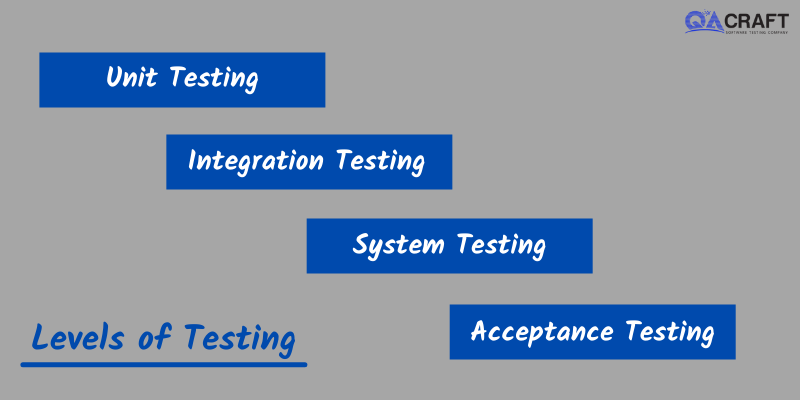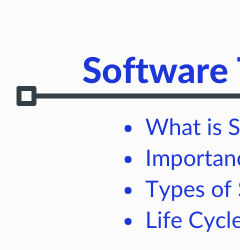22 Oct

Introduction: Levels of Testing
The purpose of Levels of testing is to make software testing structured/efficient and easily find all possible test cases/test scenarios at a particular level. In the SDLC model, there are personalized phases such as requirement meeting, analysis, coding, design, execution, testing, and deployment. These all phases go through the process of levels of testing in software testing.
Many different testing levels are used or help to check actions and performance for software testing. These testing levels are designed for missing areas and re-coded and re-linked between the development lifecycle states.
Levels of Testing in Software Testing
In general, mainly four levels of testing in software testing: Unit Testing, System Testing, Integration Testing, and Acceptance Testing.
- Unit Testing
- Integration Testing
- System Testing
- Acceptance Testing

Every testing level is crucial testing for software testing but these four levels of testing are crucial testing for software engineering.
Unit Testing
This type of testing uses tests for a single component or a single unit in software testing and this kind of testing is performed by the developer.
Unit testing is also the first level of functional testing. The primary goal of unit testing is to validate the performance of unit components.
Unit is the smallest testable portion of the system or application. The main aim is to test that each component or unit is correct in fulfilling requirements and desired functionality.
The main advantage of this testing is that by detecting any errors in the software early in the day is that by doing so the team reduces software development risks, as well as time and money wasted in having to go back and take back fundamental defects in the program once it is nearly completed.
Integration Testing
Integration testing means combining different software modules and phases and testing as a group to ensure that the integrated system is ready for system testing or not, and there are many ways to test how different components of the system function at their interface.
This type of testing is performed by testers and integration testing finds the data flow from one module to other modules.
System Testing
System testing is most probably the final test to identify that the system meets the specification and criteria and it evaluates both function and non-functional needs for the testing.
System testing is allowing to check the system’s compliance as per the requirements and all the components of the software are tested as a whole to ensure that the overall product meets the requirements specified. It involves load, reliability, performance, and security testing.
System testing is a very important step as the software is almost ready for production in the market and once it is deployed it can be tested in an environment that is very close to the market/user-friendly environment which the user will experience.
Acceptance Testing
Acceptance testing aims to evaluate whether the system complies with the end-user requirements and if it is ready for deployment.
The tester will utilize a different method such as pre-written scenarios and test cases to test the software and use the results obtained from these tools to find ways in which the system can be improved also QA team or testing team can find out how the product will perform when it is installed on the user’s system.
Acceptance testing ranges from easily finding spelling mistakes and cosmetic errors to relatable bugs that could cause a major error in the application.
Other Types of Testing:
- Regression testing
- Alpha testing
- Beta testing
- Pair/Buddy testing
Conclusion:
- All the levels of testing are compulsory and have to be finished before the application/software is launched. Meanwhile, to check the most important facts, you may want to check out the types of software testing.
- It is advisable to test as early as possible and test frequently.
- By adopting a constant vigilance and checking viewpoint in all your projects, as well as by a systemized approach to testing, the tester can detect any defects in the system as soon as possible, which is a waste of time and money later.
Read Also:
I am Priyanka Kantharia. I am working as a Software Test Engineer at QACraft. My Qualification is MCA. I have 4 years of work experience as a QA. My hobbies are watching movies, and listening music.
Related Post
Categories
- Agile Testing
- Alpha Testing
- Android App Testing
- API Testing
- Automation Testing
- Banking Domain Testing
- Beta Testing
- cloud testing
- Corporate Life
- cross browser testing
- Cypress Testing
- desktop testing
- Difference
- Domain Testing
- E-commerce Website Testing
- E-learning App Testing
- End-To-End Testing
- Functional Testing
- Game Testing
- Healthcare Domain Testing
- Integration Testing
- Interview Questions
- ios App Testing
- Jenkins
- JIRA
- Katalon
- Manual Testing
- Mobile App Testing
- Monkey Testing
- Non-Functional testing
- Performance Testing
- Postman
- Regression Testing
- Salesforce Testing
- Sanity Testing
- security testing
- Selenium Testing
- Smoke Testing
- Software Testing
- Static Testing
- Test Case
- Test Environments
- Test Scenario
- Test Script
- TestRigor
- Web Application Testing
© Copyright 2025 QACraft Pvt. Ltd. All rights reserved.
Contact : +91 9157786796




Priyanka Kanthariya